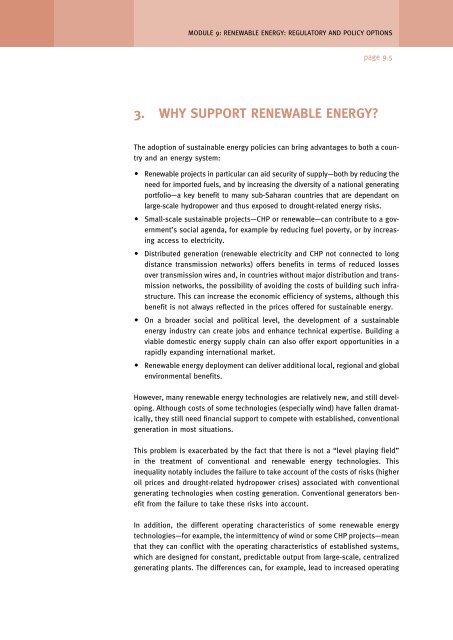Regulatory and policy options to encourage development of ...
Regulatory and policy options to encourage development of ...
Regulatory and policy options to encourage development of ...
- No tags were found...
You also want an ePaper? Increase the reach of your titles
YUMPU automatically turns print PDFs into web optimized ePapers that Google loves.
MODULE 9: RENEWABLE ENERGY: REGULATORY AND POLICY OPTIONSpage 9.53. WHY SUPPORT RENEWABLE ENERGY?The adoption <strong>of</strong> sustainable energy policies can bring advantages <strong>to</strong> both a country<strong>and</strong> an energy system: Renewable projects in particular can aid security <strong>of</strong> supply—both by reducing theneed for imported fuels, <strong>and</strong> by increasing the diversity <strong>of</strong> a national generatingportfolio—a key benefit <strong>to</strong> many sub-Saharan countries that are dependant onlarge-scale hydropower <strong>and</strong> thus exposed <strong>to</strong> drought-related energy risks. Small-scale sustainable projects—CHP or renewable—can contribute <strong>to</strong> a government’ssocial agenda, for example by reducing fuel poverty, or by increasingaccess <strong>to</strong> electricity. Distributed generation (renewable electricity <strong>and</strong> CHP not connected <strong>to</strong> longdistance transmission networks) <strong>of</strong>fers benefits in terms <strong>of</strong> reduced lossesover transmission wires <strong>and</strong>, in countries without major distribution <strong>and</strong> transmissionnetworks, the possibility <strong>of</strong> avoiding the costs <strong>of</strong> building such infrastructure.This can increase the economic efficiency <strong>of</strong> systems, although thisbenefit is not always reflected in the prices <strong>of</strong>fered for sustainable energy. On a broader social <strong>and</strong> political level, the <strong>development</strong> <strong>of</strong> a sustainableenergy industry can create jobs <strong>and</strong> enhance technical expertise. Building aviable domestic energy supply chain can also <strong>of</strong>fer export opportunities in arapidly exp<strong>and</strong>ing international market. Renewable energy deployment can deliver additional local, regional <strong>and</strong> globalenvironmental benefits.However, many renewable energy technologies are relatively new, <strong>and</strong> still developing.Although costs <strong>of</strong> some technologies (especially wind) have fallen dramatically,they still need financial support <strong>to</strong> compete with established, conventionalgeneration in most situations.This problem is exacerbated by the fact that there is not a “level playing field”in the treatment <strong>of</strong> conventional <strong>and</strong> renewable energy technologies. Thisinequality notably includes the failure <strong>to</strong> take account <strong>of</strong> the costs <strong>of</strong> risks (higheroil prices <strong>and</strong> drought-related hydropower crises) associated with conventionalgenerating technologies when costing generation. Conventional genera<strong>to</strong>rs benefitfrom the failure <strong>to</strong> take these risks in<strong>to</strong> account.In addition, the different operating characteristics <strong>of</strong> some renewable energytechnologies—for example, the intermittency <strong>of</strong> wind or some CHP projects—meanthat they can conflict with the operating characteristics <strong>of</strong> established systems,which are designed for constant, predictable output from large-scale, centralizedgenerating plants. The differences can, for example, lead <strong>to</strong> increased operating










